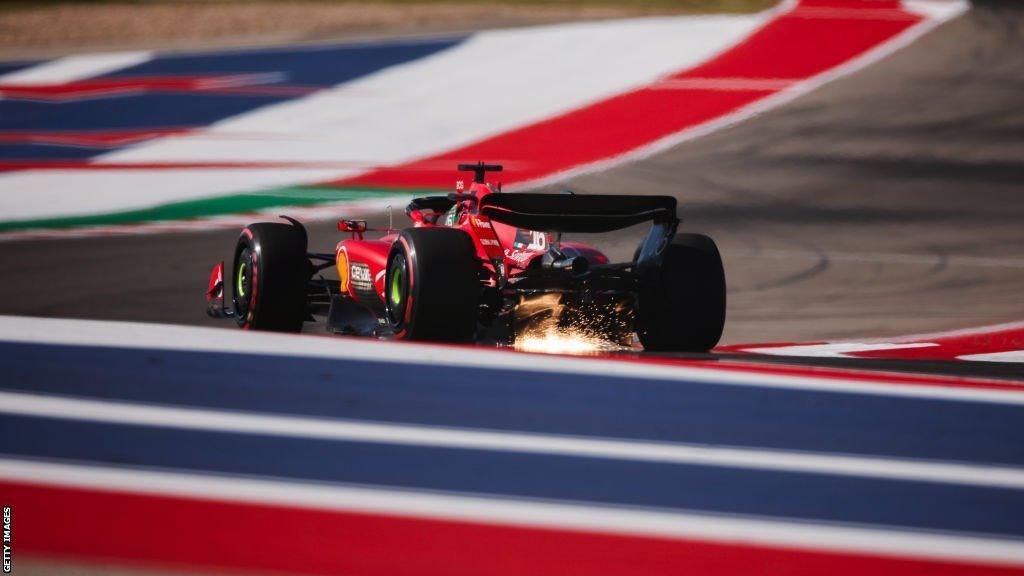United States Grand Prix: 'How did Mercedes make such a mistake?'
- Published

Hamilton was eventually disqualified despite taking second place in the race
What had been the best race of Mercedes' difficult 2023 season was wrecked when Lewis Hamilton's car was disqualified from the United States Grand Prix for a technical infringement.
The seven-time champion had finished the race at the Circuit of the Americas in Austin, Texas, just two seconds behind race-winner Max Verstappen's Red Bull.
And that result came despite Mercedes admitting that they had made a major strategic blunder without which they could even have won the race - and would certainly have forced Verstappen to pass Hamilton to win on a day when Red Bull did not have their usual performance advantage over the rest.
But the reason for Hamilton's disqualification rendered moot any conclusions about his performance in a car that featured an upgrade which he said had made a significant difference to its behaviour.
Hamilton, along with Ferrari's Charles Leclerc, was thrown out of the results for excessive wear of the underfloor skid blocks in the car's 'plank'.
These are used to control ride-height, to prevent teams running their cars too low. And the reason governing body the FIA wants to do so is that usually running a car low makes it faster.
The upgrade on the Mercedes was a new floor, which Hamilton said had transformed its balance.
All year, Hamilton and team-mate George Russell been complaining about the car's lack of rear grip, which they say has robbed them of the confidence they need to commit to corner entry.
This is where Hamilton said the car had improved.
"The step we were able to take this weekend has given me a little bit more confidence in the car to throw it into the corners," the seven-time champion said.
"I really enjoyed driving around this track. There are still some of the fundamental issues we are having with the car which won't change until next year. But it was really positive to feel the step we had taken.
"Maybe it was only 0.1secs upgrade (in terms of theoretical car performance) but there was at least a 0.1secs of confidence it gave me. It is quite interesting when you see what happens when you do have those; it's like a double knock-on effect."
An added benefit was that the upgrade had improved the car's relative performance compared to its rivals in areas of the track where its weaknesses were most highlighted - high-speed corners.
In Japan, two races ago, the Mercedes was uncompetitive through Suzuka's Esses compared to all other front-running cars.
But in the Esses at Austin this weekend, which are quite similar in nature to those at Suzuka in being a series of high-speed changes of direction, the Mercedes was competitive. As team principal Toto Wolff put it: "It was our best sector."
What Mercedes will not know until next weekend's Mexican Grand Prix at least is whether running the car low enough to contravene the rules on skid-block wear had an effect on these gains.
Insiders at the team admitted that the mistake they made would have made some difference to the car's performance, but suspected it would not have led to any significant advantage. And they were confident that the upgrade had made a positive difference to the car.
That meant they left the track feeling relatively pleased about making a performance step forward, even if they were fed up that the car had been disqualified for what they believed was an oversight caused by the specific circumstances of the weekend.
But it is simply not possible to know that, and it will take the evidence of a few more races to conclude whether the floor update has had the effect they believe it has.
How can a team such as Mercedes make such a mistake?
It was down to the combination of perhaps the bumpiest track on the calendar and a sprint weekend, which forces teams to lock in a set-up after just one practice session on Friday.
After that, they are into qualifying for the grand prix and then the sprint Saturday format. All through this the cars are in what is known as 'parc ferme' and teams are unable to make changes without being forced to start from the pit lane.
The stewards' verdict in Austin said that Mercedes - and Ferrari - had "stated that the high wear on the skid pads was probably a result of the unique combination of the bumpy track and the sprint-race schedule that minimised the time to set up and check the car before the race".
A glance at the on-board cameras of the cars of Hamilton and team-mate George Russell showed how much the drivers were suffering from the bumps at the Circuit of the Americas.
Russell's car was not checked by the scrutineers, incidentally, and nor was that of Leclerc's team-mate Carlos Sainz. The way FIA scrutineering works is that cars are checked at random. If a transgression is found, that does not mean that the other car in the team is then checked as well.

Leclerc was also disqualified
Why is running low an advantage?
F1 cars develop most of their performance from the underfloor, using an aerodynamic phenomenon known as 'ground effect'. This creates a low-pressure area under the car that sucks it towards the ground.
Generally, the lower the car runs, the more the downforce it creates. The limiting factor is a phenomenon known as 'porpoising'.
This is when the underbody airflow is disrupted and 'stalls' - which happens if the floor gets too low. It causes a sudden rise of pressure, which makes the car rise. Then the aerodynamics start working again, pulling the car down until it is low enough to trigger the effect again, setting up a motion where the car bounces up and down violently several times a second.
Red Bull's advantage this year has been founded in their ability to run their car lower than rivals without triggering porpoising.
It is too early to tell whether Mercedes' upgrade has enabled them to run their car lower in the same way.
What was Mercedes' strategy blunder?
Before the infringement, the focus at Mercedes was on a race they felt might have got away from them through strategy errors.
Hamilton was running second behind McLaren's Lando Norris as the first pit stops approached, with Verstappen just under five seconds behind.
When Norris and Verstappen pitted, Mercedes chose to try for a one-stop strategy, confident that tyre degradation was lower than normal.
It was a decision based on the superiority of the Red Bull this season, and the fact that, if they had locked in track position a few seconds ahead of Verstappen, on normal form, he would have passed them anyway. The one-stop, they felt, was something different that might give them a chance.
But within two laps, Hamilton's tyres had fallen off a cliff and he had to pit just three laps after Norris and four after Verstappen.
That consigned him to a race of catch-up where he would be coming back at them in the final stint on fresher tyres.
But those few laps before Hamilton pitted had cost him 10 seconds to Verstappen, and it was just too much to make up, even with the world champion struggling with his brakes and not able to drive as he wished.
It was too much for Hamilton to overcome.
Given Verstappen was not as quick as usual, probably at least partly because of his brake problem, would Mercedes have actually been able to hold him off if they had gone for what they admitted in hindsight would have been the right strategy and pitted at the same time? They will never know.
Afterwards, Wolff spoke of "mixed feelings because the pain of having lost a race we could have won" but said that "overall we can be pleased".
A few hours later, he was forced to revise those thoughts. The compensation is that with races coming thick and fast - Austin is followed on consecutive weekends by Mexico and Brazil - Mercedes won't have too long to wait before they get an answer to the questions now lingering around them.
